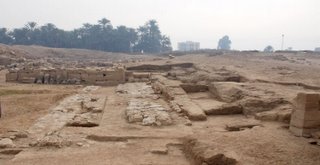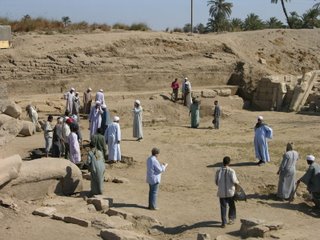 We finished up the south side of Temple A's Forecourt late last week. The various limestone and mud brick walls are now clearly defined, from the wall running east off the Lepsius Gate (right) to the foundations of the Forecourt's colonnade.
We finished up the south side of Temple A's Forecourt late last week. The various limestone and mud brick walls are now clearly defined, from the wall running east off the Lepsius Gate (right) to the foundations of the Forecourt's colonnade.In the left photo, Elsie Peck (lower center) supervises workmen as they begin work in the area of the entrance to Temple A, while work on the Forecourt's north wall continues in the background. The photo on the right, taken at the end of this week, looks west along the remains of the paving of the gateway in the temple's 1st Pylon; not much remains. We have now cleared the entire length of the enclosure wall, the north wall of the Forecourt, and have uncovered the bases and footings of the colonnade on this side of the court. The apparent 2nd wall between the enclosure wall and the wall of the Forecourt (mentioned last time) turns out to be a mud-brick re-facing that was coated in plaster.
We have now cleared the entire length of the enclosure wall, the north wall of the Forecourt, and have uncovered the bases and footings of the colonnade on this side of the court. The apparent 2nd wall between the enclosure wall and the wall of the Forecourt (mentioned last time) turns out to be a mud-brick re-facing that was coated in plaster.

In the past 2 weeks we have been able to start dismantling the Roman Period structures built against the Mut Temple's 1st Pylon (top). In the lower photo, Qufti Mahmoud Abbadi, an extraordinarily skilled archaeologist, brushes off the top of a brick wall to make the brick patterns clear.


Mahmoud, Bill Peck and I discuss the newly-revealed bricks while two workmen look on. It turns out this wall wasn't a single construction as we originally thought. The row of bricks under Mahmoud's hand is a later phase, probably added to support a vaulted roof.Once we're agreed, Bill begins to add the new details to his map of the area. The backdrop of temple, village and mountains is spectacular. Dr. W. Benson Harer was able to join us again this season for a few weeks, and we promptly set him to work drawing pottery we have excavated. This is exacting work requiring a good eye, a steady hand, and much patience, all of which Dr. Ben has in abundance. Pottery drawing isn't glamorous but it is an important part of archaeological work. Thanks, Ben.
Dr. W. Benson Harer was able to join us again this season for a few weeks, and we promptly set him to work drawing pottery we have excavated. This is exacting work requiring a good eye, a steady hand, and much patience, all of which Dr. Ben has in abundance. Pottery drawing isn't glamorous but it is an important part of archaeological work. Thanks, Ben.


In the photo on the left you can see the restored east wall of the East Porch. Once that work was finished, we could go ahead and remove the fallen column that has lain across the area for hundreds of years so that we can excavate below it. The column drums are large and awkward to handle, but the area was cleared in a day.
 Where the fallen column once lay we found a few remains of paving (center foreground), but most of the paving in this area was robbed out long ago.
Where the fallen column once lay we found a few remains of paving (center foreground), but most of the paving in this area was robbed out long ago. With the work on the south side of Temple A completed, we could turn to work in the area of Chapel D, west of the Precinct entrance. We are excavating the west side of the building both to discover how it relates to the enclosure wall behind it and to the Taharqa Gate immediately to its west and to provide enough space to carry out conservation work on the wall.
With the work on the south side of Temple A completed, we could turn to work in the area of Chapel D, west of the Precinct entrance. We are excavating the west side of the building both to discover how it relates to the enclosure wall behind it and to the Taharqa Gate immediately to its west and to provide enough space to carry out conservation work on the wall.

 The north side of the big limestone block contains what appears to be part of an offering scene, but the accretions on the surface make it difficult to see details (left). Lisa Bruno, Brooklyn Museum conservator, couldn't have arrived at a better time. As you can see, the space she has to work in is very tight, but Lisa is patient and determined.
The north side of the big limestone block contains what appears to be part of an offering scene, but the accretions on the surface make it difficult to see details (left). Lisa Bruno, Brooklyn Museum conservator, couldn't have arrived at a better time. As you can see, the space she has to work in is very tight, but Lisa is patient and determined.


The SCA has selected a sculptures from a number of sites in Luxor and elsewhere to be exhibited in the new Museum of Civilization in Cairo. Among the objects chosen are several uncovered and/or restored by the Brooklyn Museum Mut Expedition. This week, officials arrived to remove the selected objects, which include this magnificent and rare granite head from a large recumbent sculpture of a ram that dates to Dynasty 25. The ram is Amun, and the figure standing below his chin is King Taharqa of Dynasty 25. We are pleased that it will eventually be on display where everyone can enjoy it.


As most of the sculptures selected for the museum, such as this figure of a baboon, are too heavy to move by hand or siba, the big crane from Karnak was brought in to lift them onto the transports.

 Since the crane was already on site, the SCA was kind enough to allow us to use it to move some large blocks in the area of Chapel D that we would otherwise not have been able to shift. Most important was a large ceiling block, which is now clearly visible for the first time in years.
Since the crane was already on site, the SCA was kind enough to allow us to use it to move some large blocks in the area of Chapel D that we would otherwise not have been able to shift. Most important was a large ceiling block, which is now clearly visible for the first time in years.
Richard Fazzini







